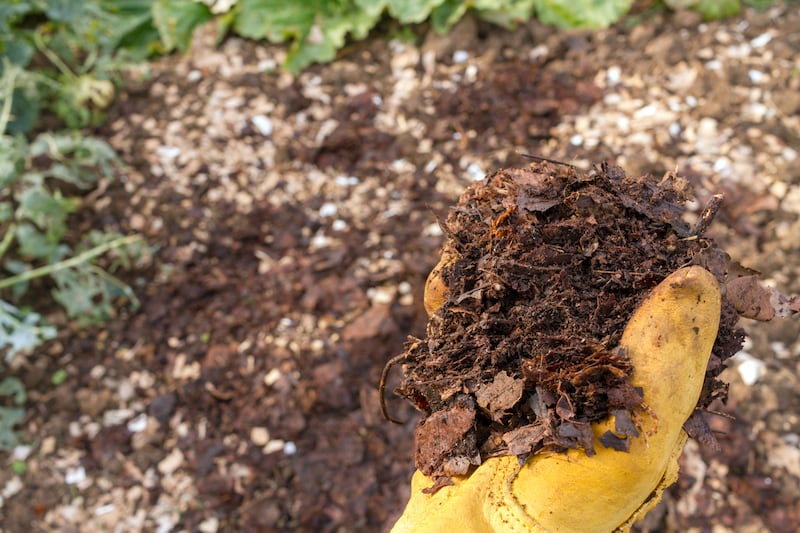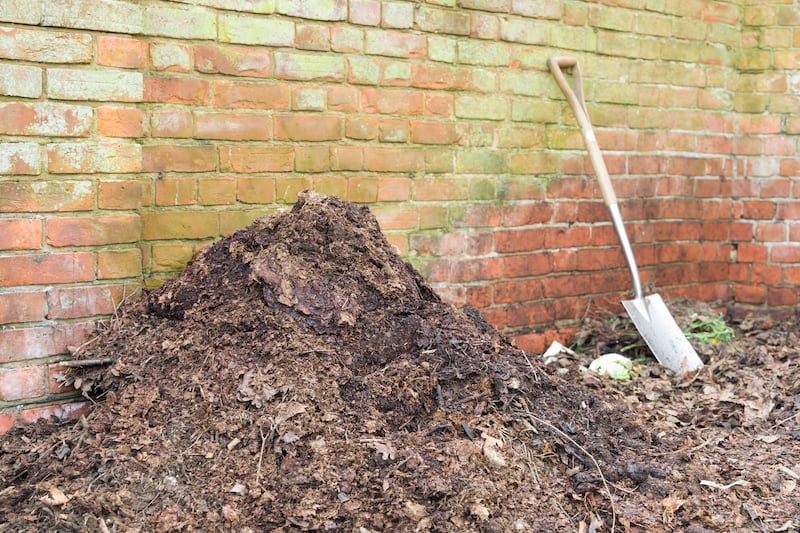When I was a child, my favourite season by a long shot was autumn. I loved the sight of it, the smell of it, the sound and sense of it. Especially the trees. Giant beech, oak and flushing gold and copper. The wild gales that sent their dying leaves swirling to the ground. The ripe, sweet, fungal smell of those same fallen leaves and the messy joy of wading up to my knees in a sea of arboreal confetti.
Now, in middle age, autumn feels altogether more bitter-sweet, but I still love its fallen leaves and the important role they play in nurturing the garden and its many life forms. Thankfully, long gone are the days when gardening columns routinely advised readers to tidily rake and collect them to burn in bonfires or to bag and dispose of in the bin. Instead we’ve learned to see autumn leaves as a precious winter blanket or natural mulch for the soil that protects it from erosion and nutrient loss and suppresses weed germination, while simultaneously insulating both plants’ root systems and soil micro-organisms against winter cold. At this time of year, those same fallen leaves also offer safe harbour for many other creatures, from hibernating hedgehogs that like to cocoon themselves snugly against low temperatures while they sleep out the coldest months of the year to frogs and newts in need of cover.
The good news, of course, is that nature is nothing if not generous, and so there’s always enough left over for us gardeners to collect from flower beds, lawns, paths, patios, driveways, garden steps and even along roadside edges to make what’s known in gardening parlance as “leaf mould”.
Leaves of conifers are slow to rot down. Seek out the fallen leaves of deciduous broad leaf species such as beech, oak, horse chestnut, birch, maple, ash, plane and sycamore
Understandably for most new gardeners, any horticultural term that includes the word “mould” may not sound all that endearing. But leaf mould is the Rolls-Royce of gardening ingredients, a chocolate-brown crumbly substance rich in humus that brings soils and seed and potting composts to life in complex ways that are truly magical. It’s also free and supremely easy to make. You simply collect the leaves (I like to use two clapperboards to do this, something I first learned the usefulness of as a student in the Bots) and then place them in some sort of a container in a cool, dark, out-of-the-way corner of your garden or allotment to rot down, a process that typically takes a couple of years.
READ MORE
[ How to keep soil healthy, happy and productiveOpens in new window ]
Some people use strong bags or sacks as containers to store their leaves, with a few holes punctured in them for drainage and aeration. Others prefer to make cylindrical cages out of chicken or sheep wire nailed or stapled to a wooden frame. The benefit of using sacks or bags is that they are portable and easily slung out of sight where space is tight. The benefit of using a wire cage is that it allows a wide range of garden wildlife to make good use of the heap as it slowly rots down, from birds feasting on the insects that will take up residence to the aforementioned hibernating hedgehogs, frogs and newts.
Whichever containers you use, think big when it comes to the quantity of leaves you collect. As it slowly breaks down, first as a result of the activity of beneficial fungi, then of bacteria, your giant pile of leaves will gradually shrink to between a third and a quarter of its original size. Seasoned gardeners will vouch for the fact that there is never, ever, ever such a thing as too much leaf mould, so do your best to collect a really generous amount of fallen leaves without stripping your garden or allotment bare.

Avoid collecting from beneath hedges, where fallen leaves nurture the soil and provide shelter for wildlife. If you plan to forage for leaves outside your own garden, then also avoid collecting them from woodland areas where nature’s annual gift of fallen leaves is key to their ecology and cycle of life. Car parks, graveyards, parks and suburban roadsides are all great places to easily collect large quantities, but for obvious reasons ask permission where required, gather with respect for wildlife, wear gloves and watch out for rubbish and hidden dog excrement. Bear in mind also that not all leaves are equal when it comes to making the perfect crumbly leaf mould. As a rule, it’s best to avoid those of most evergreen species of trees and shrubs such as holly, laurel and griselinia which are very slow to rot down. Those of conifers are also slow to rot down, and are only suitable for making leaf mould to use as a mulch/compost amendment where you’re growing ericaceous species. Instead seek out the fallen leaves of deciduous broad leaf species such as beech, oak, horse chestnut, birch, maple, ash, plane and sycamore.
Also bear in mind that unlike a compost heap, which can rapidly heat up to broiling temperatures, a leaf pile will only heat up briefly and gently, and then quickly cool off as winter sets in. Fungal activity that depends on a cool, damp environment will kick off the natural process of decay and will then gradually be replaced by bacteria that will slowly complete the process of transforming those damp, rotting leaves into leaf mould. If you want to speed the process up a little, run a lawnmower over the leaves first to shred them. If they’re very dry (an unlikely scenario given the sodden weather of recent months), then make sure to dampen the leaves immediately after bagging. Similarly, in hot, dry weather make sure to keep the rotting leaves cool and damp to sustain the natural process of decay.

How will you know when it’s ready to use? Well-rotted leaf mould should be sweet-smelling, dark and finely crumbed, with no obvious trace of the leaves that it was made from, a process that takes an absolute minimum of a year. So the leaves that you harvest in the coming weeks should be transformed into leaf mould by very late autumn of 2024, albeit not of the very finest vintage, at which point you can use it as a mulch around trees or shrubs or work it into the soil when planting or sowing.
Like a great wine, it will only improve with age. Two-year old leaf mould is a thing of sweet perfection, brilliant as a home-made low-nutrient seed compost (put it through a soil sieve first to remove any coarse particles or twigs), and then use it half and half with a sharp sand or vermiculite. Two-year-old leaf mould can also be used as a finely graded mulch for plants (including indoor plants) or to make a home-made potting compost when mixed half and half with very well-rotted home-made garden compost taken from a cool heap. In this way you can avoid the use of peat-based products that are bad for the planet while using a locally sourced, widely available, entirely natural ingredient, which is about as sustainable as it gets. And all for free. How good is that?
This week in the garden
Check polytunnels and glasshouses for tears in the plastic, broken panes of glass, damaged vents, doors or window hinges, or any fallen branches that might be threatening their structural integrity following the recent gale force winds associated with Storm Debi. Quick repair is important to prevent these becoming even more of a problem in the winter months ahead.
Protect the root balls of outdoor container-grown plants from becoming waterlogged by raising them above the ground level by 2cm-5cm using pot “feet”. Waterlogged plants are much more vulnerable to being killed by disease or by harsh winter frosts, while waterlogged soil also impedes health growth and can even cause spring-flowering bulbs to rot in the compost before they get a chance to emerge.
Dates for your diary
Thursday, November 23rd (8pm): Northridge House, St Luke’s Castle Road, Mahon, T12H970, Cork, on behalf of Cork Alpine Hardy Plant Society, a screening of the film Wildside: Story of a Garden, which tells the tale of Keith and Ros Wiley’s extraordinary and innovative garden in Devon, Wildside. All welcome, visitors €10
November 22nd (7.30pm-9pm): A zoom talk by Peter Wyse-Jackson of Missouri Botani Gardens on behalf of the RHSI. rhsi.ie
Sunday November 26th, Sunday December 3rd and Sunday December 10th (10am-1pm): The Grinding House, June Blake Garden, Tinode, Blessington, Co Wicklow, seasonal Christmas wreath-making workshops with garden writer and flower-farmer-florist Fionnuala Fallon. eventbrite.com/o/fionnuala-fallon-74563213293 or @theirishflowerfarmer to book tickets
November 28th (8pm-9.30pm): Foxrock Church Pastoral Centre, Dublin 18, Travels on Easter Island, a talk by nursery owner and RHS Chelsea gold medal winner Billy Alexander, on behalf of the Foxrock & District Garden Club, see foxrockgardenclub.com




















